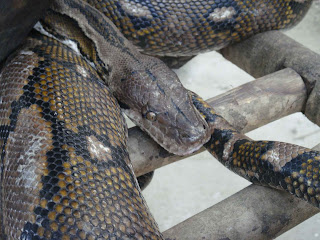The Burmese Python is on the list to be one the largest snakes in the world. An average size of this snake can reach up to 12 feet in length but some rare specimens are reported to have reached as long as 20 feet. This reptile is nocturnal and are rarely seen active during the day. Spends most of the time hiding in holes on rocks, trees and undergrounds.
Scientifically named as Molurus Bivittatus, this snake has vivid skin color of brown with border patterns of light brown and yellow. Albinos are colored white with border patterns of a high contrast yellow. An interesting fact of this reptile is that it can go underwater for half an hour.
Being a carnivore, the Burmese Python feeds usually on rodents, birds and sometimes animals that are proportion to its size. It kills its prey through constriction. A method of wrapping its body on the victim and squeezing it until it dies.
 |
| An Albino Burmese Python |
Burmese pythons are commonly found in the tropic areas of Asia. Though they found their habitat in marshlands or areas near water, there are also sightings of these snakes in grasslands and rocky foothills.
This reptile breeds mostly in spring time. One characterisic of the Females of this snake is that it takes care for its eggs very well. They wrap their body around the eggs to give sufficient temperature to make it warm. They are known to stay on their nest having a watchful eye on the eggs until it hatches and can lay up to 40 eggs per clutch.
This reptile breeds mostly in spring time. One characterisic of the Females of this snake is that it takes care for its eggs very well. They wrap their body around the eggs to give sufficient temperature to make it warm. They are known to stay on their nest having a watchful eye on the eggs until it hatches and can lay up to 40 eggs per clutch.
Burmese Pythons in Cebu Zoo can be found on a plastic container where you can get hold of these snakes and have a picture taking.
 |
| Young Burmese Pythons in Cebu Zoo. |




